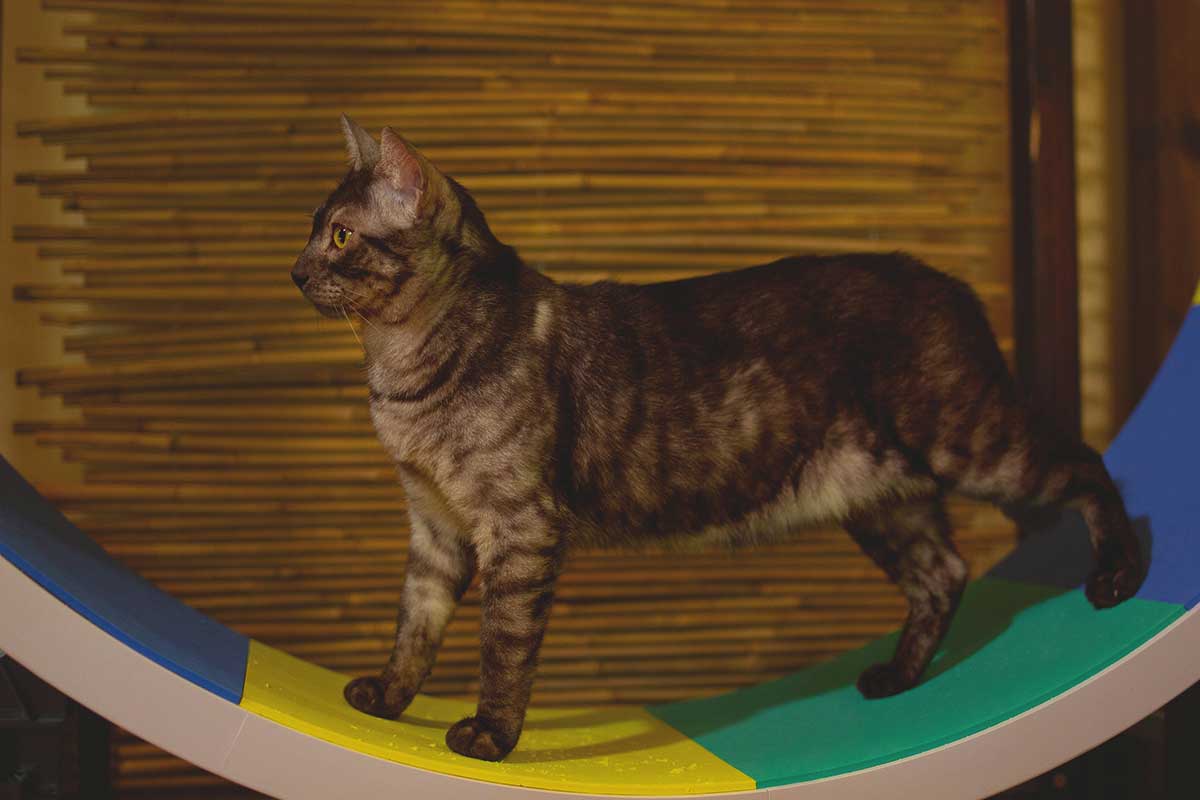Is your cat fat? Inactive? Bored?
That’s not normal or healthy, and here’s why. Cats instinctively nap 16 or more hours daily. Back when they lived outdoor lives, napping was a mechanism to reserve energy to keep their hunting skills sharp. But in a time when most cats live indoors, with no need to hunt for survival, it’s crucial to provide them with opportunities to expend that pent-up energy. Not just for entertainment, but for good health.
Just like humans, cats who laze around and get little or no exercise can become obese and vulnerable to diseases such as arthritis, heart disease, diabetes, and liver problems. Living the same daily routine can also cause stress that manifests in destructive or aggressive behaviors such as destroying furniture, not using the litter box, or fighting with other cats in the household.
An exercise wheel can be a way to help your cat become or stay more active, offering diverse benefits for mental health and physical wellbeing. You’ve probably seen videos on social media of cats running on giant exercise wheels and wondered about getting one for your own cat. Here’s the scoop on what to consider.
How It Works
Resembling giant hamster wheels, feline-powered treadmills revolve under the cat’s weight. They are gaining in popularity as entertainment for adult cats, especially those who are left alone most of the day with nothing to do.
The wheel is not meant to replace other methods of play, in particular those that encourage feline-human interaction, but is an additional exercise routine, especially for cats who may still have plenty of energy after playing with plush mice or crinkle balls. An exercise wheel is something they can use whenever they want, day or night, when no humans are available for play.
Benefits And Precautions
Beyond the exercise and entertainment wheels can provide, they also have numerous health benefits, says Marybeth Rymer, DVM, at VCA Monte Vista Animal Hospital in Concord, California. Those benefits include weight loss, leading to reduced risk of type 2 diabetes, heart, and respiratory disease; improved muscle tone, muscle mass, and joint flexibility, all of which aid in arthritis management; increased confidence and mental stimulation; and reduced depression, anxiety, and behavioral issues. For owners planning to introduce a wheel for a senior cat or one with pre-existing conditions, Dr. Rymer recommends scheduling a veterinary exam first to make sure the cat doesn’t have any conditions that might be aggravated by the exercise.
Despite the benefits, exercise wheels are not for every cat—or every home. At an average of 60 inches in diameter and 14 inches in width, they take up a lot of floor space.
They are expensive, too, costing quite a bit more than the average puzzle toy or finest quality catnip mouse. Depending upon the brand purchased, they start at $199 and up, with no guarantee that a cat will use it.
If you decide to purchase a wheel, choose one with an open design that allows the cat to enter from either side without feeling trapped. Inspect it thoroughly after assembly to ensure all parts fit snugly and work smoothly. Dr. Rymer recommends spot checking it weekly to make sure it remains in optimal condition.
Training Wheels
For a cat with moderate to high energy levels, such as those inclined to race through the house in short spurts, an exercise wheel is probably a good fit. Cats who are easily trained and motivated by food or other rewards are also typically good candidates. Every cat is different, though, and it’s wise to consider their personality before making the investment.
Some cats take to exercise wheels right away. One company says the cats most likely to use their wheels are Bengals, Toygers, Savannahs, Egyptian Maus, Russian Blues, Abyssinians, Siamese, and Maine Coons. As with anything, though, your mileage may vary.
No matter what their breed or energy level, cats may need training and time before they begin to use an exercise wheel. Be patient and use enticements such as sprinkling catnip on the wheel, offering tasty treats, or sparking their interest with a feather toy. Once a cat is accepting and acclimated, wheels are a safe, fun, challenging, and effective way to keep their minds sharp and bodies fit.
Deborah Barnes is an award-winning author and blogger at Zee & Zoey’s Cat Chronicles and President of the Cat Writers’ Association. She is also secretary of the nonprofit Pawsitively Humane Inc. of Miami, Florida, and most recently has ventured into designing cat-related T-shirts and accessories.
This article was reviewed/edited by board-certified veterinary behaviorist Dr. Kenneth Martin and/or veterinary technician specialist in behavior Debbie Martin, LVT.








